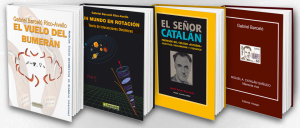PRESS RELEASE
The “Flight of the Boomerang” explains his Theory of Dynamic Interactions
THE JOURNAL OF APPLIED MATHEMATICS AND PHYSICS PUBLISHES THE SCIENTIST GABRIEL BARCELO’S THEORY OF DYNAMIC INTERACTIONS
- His Theory of Dynamic Interactions casts doubts on the classical theory, and it may greatly affect the foundations of dynamics, astrophysics, cosmology and atomic physics.
- This new theory could explain phenomena such as tornadoes, boomerangs guiding of a spacecraft or steering of ships without a blade rudder.
Madrid, xx May, 2015.- The prestigious American Journal of Applied Mathematics and Physics Vol.3, No.5, published this month the new article on the Theory of Dynamic Interactions: The Flight of the Boomerang II, written by the Spanish scientist Gabriel Barceló. This theory, that questions classical theory, may explain phenomena such as tornadoes, the guiding of a spacecraft or steering of ships without a blade rudder.
This article is the second part to the paper that was published in volume 2 of the same scientific journal. This paper presents a view on the Theory of Dynamic Interactions. The boomerang dynamic behaviour is a clear example of the application of this theory. As Gabriel Barceló explains, “after its launch, the boomerang begins to rise practically vertically and rotate like a disk. It then drops gradually travelling in a circular path, doing a complete turn, without ever ceasing to rotate on itself. It is this peculiar closed path that some experts find complicated when explaining how a rocket is put into orbit”.
The article includes a video, produced by Javier Sánchez Boyer, illustrating the Boomerang dynamic behaviour, which can be viewed at:
https://www.dropbox.com/s/6h8lso3gbexck0j/Bomerang_v3_Mini.mp4?dl=0
The flight of the boomerang illustrates this theory
The boomerang is a particularly significant case of a rotating body. Numerous texts have been written to try to explain the flight of the boomerang, but the reason behind its path and its behaviour in flight remain unanswered, until now, in the context of Classical Mechanics. The document proposes a nature in which bodies with intrinsic rotation do not behave in accordance with the laws of Classical Mechanics. This new proposal, based on non-Newtonian hypotheses, could easily explain the paradoxical and surprising flight of the boomerang, as well as the dynamic behaviour of so many bodies that are not easily understood in the context of Classical Mechanics. The article presents keys to interpret the behaviour of galaxies or of Saturn’s rings, under a new perspective.
This Theory proposes that when a rigid body is subject to successive torque, the first momentum will generate its intrinsic rotation, but successive non-coaxial momenta generate a non-uniform field of velocities, which can be identified as anisotropic distribution of acceleration, and mathematically it can be considered as an inertial force field. If the rigid body also has kinetic translational momentum, the translational velocity field will join the anisotropic field of velocities generated by the second momentum, thus forcing the centre of mass of the mobile object to modify its path, without any external force being applied in that direction. Therefore, in the dynamic phenomena that operate under these hypotheses, kinetic rotational energy will be transferred into translational energy, and vice-versa.
Repercussions of the Theory of Dynamic Interactions
The Theory of Dynamic Interactions may substantially affect the foundations of dynamics, with applications in astrophysics, cosmology, atomic physics, etc. It generalises the concept of gyroscopic torque and other inertial phenomena, adding them to a unified structure of a new non-inertial rotational dynamics. “The Flight of the Boomerang” suggests new dynamic hypotheses for non-inertial systems, which could be quite significant in the configuration of physics. This proposal is clearly unorthodox, therefore it is expected that the new theory will not be accepted without a controversy.
This theory has multiple possibilities for scientific and technological applications. The Theory of Dynamic Interactions could contribute to the efficient steering of a ship without a blade rudder, thus saving energy, or the guiding of a spacecraft. The theory could also be applied in confining plasma in nuclear fusion reactors, or even in research on tornadoes.
Further information:
Roatan Comunicación – Patricia Cavanillas – 91 563 67 80 – pcavanillas@roatan.es
http://www.advanceddynamics.net/
http://www.dinamicafundacion.com/
☏ (+34) 914 112 823 (+34) 915 614 107
@ comunicacion@advanceddynamics.net
✉ C/ Pedro de Valdivia, 31
28006 Madrid (Spain)


